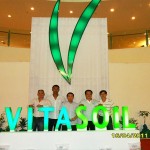pepsinogen and trypsinogenbissell power steamer heavy duty 3-in-1 manual
On the contrary, pepsinogen is activated only by means of acidification below pH 5.4 instead of addition of DIGESTION AND ABSORPTION OF PROTEINS BY DR SHRADDHA BHARATH PG STUDENT ESIC-MC & PGIMSR BANGLORE-10 DEPARTMENT OF BIOCHEMISTRY. On the contrary, pepsinogen is activated only by means of acidification below pH 5.4 instead of addition of protease, whereas con- formational change and release of some peptides from a part of pepsinogen molecule occur in the process of activation similarly to trypsin- ogen and chymotrypsinogen. Once pepsin is formed it itself converts pepsinogen into pepsin. How Pepsinogen and trypsinogen is activated? Second, an intramolecular activation mechanism, a kinetically first . The activated . Trypsinogen is active only after its eight-amino-acid-long activation peptide has been cleaved off by . Frank Deis Have taught Mol Bio and Biochem for 43 years. Trypsinogen [D12.776.811.243.885] Expand All. View chapter > Revise with Concepts. The inactive form of the pepsin is pepsinogen while the inactive form of the trypsin is trypsinogen. Pepsinogen is a powerful and abundant protein digestive enzyme secreted by the gastric chief cells as a proenzyme and then converted by gastric acid in the gastric lumen to the active enzyme pepsin. Pepsinogen is a very powerful and abundant protein digestive enzyme that is secreted by the gastric chief cells as a proenzyme and then is converted by gastric acid in the gastric lumen to the active enzyme pepsin. Trypsinogen and Pepsinogen STUDY PLAY Trysinogen an inactive substance secreted by the pancreas from which the digestive enzyme trypsin is formed in the duodenum Pepsinogen a substance that is secreted by the stomach wall and converted into the enzyme pepsin by gastric acid YOU MIGHT ALSO LIKE. Trypsinogen is activated by enterokinase, which cleaves an amino-terminal activation peptide (TAP). Pepsin is produced by stomach glands. The two main types of trypsin . Pepsinogen is activated by the stomach's low pH environment and inactivated by the high pH (6) in the duodenum mast cells and enterochromaffin-like cells release histamine, which acts on parietal cell H2 receptors to release hydrochloric acid. Trypsins are produced by the pancreas, stomach, and intestines in response to food. Digestion and Absorption NEET Questions -Set-4. 1957 Sep; 16 (3):791-801. Hy suy ngh v tr li cu hi trc khi xem p n. Enterokinase secreted from duodenum converts trypsinogen to trypsin, which then converts chymotrypsinogen to chymotrypsin . Gastric chief cells secrete pepsin as an inactive zymogen called pepsinogen. . Answer: Trypsinogen into trypsin. Trypsinogen is a pancreatic proteinase with two main isoenzymes, 1 and 2. Chicken pepsin stability is temperature dependent with stability up to . Pepsinogen l mt loi: A. Isoenzym. Posted Jul 22, 2020. Pepsins of human gastric juice These isoenzymes can be separated by agar gel electrophoresis at pH 5.0 or anion exchange high-performance liquid chromatography. Parietal cells within the stomach lining secrete hydrochloric acid that lowers the pH of the stomach. 2. Once in duodenum, enteropeptidase activates trypsinogen by removing 7-10 amino acid from N-terminal region known as trypsinogen activation peptide (TAP). View solution > View more. Expert Answer. How Pepsinogen and trypsinogen is activated? - (c) They are all inactive. 1. Pepsin is a protease, meaning that it cleaves bonds in proteins. 3. Pepsins of human gastric juice Trypsin and trypsinogen are produced and released by the pancreas. 1. B. Trypsinogen into trypsin. D. Enzym thuc nhm Decarboxylase. Active trypsin then . pepsinogen. If you use your own pancreas, you can collect the trypsinogen and pepsinogen that are produced in your pancreas, and then you can add them to the pre-digested pepsinogen that you have already made. 1. A low pH (1.5 to 2) activates pepsin. . Optimal pH: The optimum pH for pepsin activity is 1.8, while trypsin works best in alkaline pH (pH 7.5-8). These activated enzymes will act on proteins, proteoses and . How Pepsinogen and trypsinogen is activated? At appropriate protein concentrations (1 mg per ml or less), a kinetically first order reaction was observed in the pH range . This is the first way. Of these 5 components, pepsin is the principal enzyme involved in digestion of protein. Pepsin is a stomach enzyme that serves to digest proteins found in ingested food. Synthesis as precursors and storage in granules protect the tissues from self--destruction by their own enzymes. In the 19th century, the role of pepsin and its precursor in protein digestion was first described. Transcribed image text: QUESTION 11 Pepsinogen is activated by: A. gastrin B. trypsinogen C. pepsinogen D. elevated pH QUESTION 12 The last leaving group in DNA ligation is: A. PPI (inorganic pyrophosphate) B. DNA C. AMP D. inorganic phosphate QUESTION 13 In general, amino acid metabolism differs from carbohydrate and lipid metabolism because: A. amino acids can not be metabolized for energy . page delivered in 0.152s . This is the main difference between these two enzymes. Trypsin is a digestive enzyme that breaks down proteins into smaller fragments that can be absorbed by your body. " which forms the lining of duodenum secretes a proteolytic enzyme called enteropeptidase which converts the inactive trypsinogen secreted by the pancreatic cells to active trypsin . Download PDF Version of Trypsin vs Pepsin Solved Answer of MCQ What feature do procarboxypeptidase, pepsinogen, fibrinogen and chymotrypsinogen have in common? 9) was pi petted in a 20 ml test tube with stopper and 55~ 70 mg of so dium bicarbonate and an equal amount of pepsinogen were introduced. A low pH (1.5 to 2) activates pepsin. Trypsinogen is activated by enteropeptidase (also known as enterokinase). Part 1: Introduction. Trypsinogen. To establish a rapid and highly sensitive assay for tumor-associated trypsinogen-2 (TAT-2) based on the time-resolved fluorescence immunoassay (TRFIA) and evaluate its potential clinical value in patients with lung cancer. C. Proenzym. Pepsin cleaves proteins to form peptides. The double-antibody sandwich method was used in detecting TAT-2 antigen concentrations, and two types of TAT-2 antibodies (coating antibodies and Eu3+ labeled antibodies . Pepsin and trypsin are proteases; the walls of the stomach and duodenum respectively are made up of proteins. Trypsin is produced by the pancreas and secreted into the small intestine. The pepsinogen secreted by the chief cells of stomach lining mixes with the gastric juices and hydrochloric acid activates and converts pepsinogen into pepsin. The aims of this study were to describe the expression of digestive enzymes (trypsinogen, chymotrypsinogen, -amylase, lipoprotein lipase, phospholipase A and pepsinogen) and their relation with orexigenic (neuropeptide Y, NPY) and anorexigenic (cholecystokinin, CCK) factors during the larval development and to evaluate the effect of weaning . Enteropeptidase is produced by the mucosa of duodenum and it cleaves the peptide bond of trypsinogen after residue 15, which is a lysine. Fed Proc. Both prorennin and trypsinogen may be capable of this type of activation mechanism (4, 12). TRYPSINOGEN is activated by an enzyme, ENTEROKINASE, secreted by the intestinal mucosa into active trypsin. On the contrary, pepsinogen is activated only by means of acidification below pH 5.4 instead of addition of protease, whereas con- formational change and release of some peptides from a part of pepsinogen molecule occur in the process of activation similarly to trypsin- ogen and chymotrypsinogen. It is first activated by hydrochloric acid to form pepsin, the active form of a protein. Preparation of denatured pepsinogen sample 1) Preparation of DNP-pepsinogen powder. 1. Hard. [Google Scholar] BALLS AK, JANSEN EF. On the contrary, pepsinogen is activated only by means of acidification below pH 5.4 instead of addition of protease, whereas con- formational change and release of some peptides from a part of pepsinogen molecule occur in the process of activation similarly to trypsin- ogen and chymotrypsinogen. The mucosa is not a flat surface. Stoichiometric inhibition of chymotrypsin. Chicken pepsinogen and pepsin have 367 and 325 amino acids, respectively. It is activated by the enzyme trypsinogen in the stomach. When pepsinogen, a folded single peptide chain, is converted to pepsin, there is a profound change in the physical and chemical properties of the protein. What causes release of trypsinogen? Once pepsinogen enters the acidic environment of the stomach, it auto-catalyzes its conversion into the fully functional enzyme pepsin, which serves to breakdown proteins into smaller amino acid . Digestion in Buccal Cavity. Gastric pits are indentations in the stomach's surface that are lined by four different types of cells. - (b) They are all produced by the pancreas. Pepsin - Inactive (zymogen) form - Pepsinogen. Trypsin and chymotrypsin are two very similar digestive enzymes that hydrolyze proteins into amino acids. H2 blockers such as cimetidine are widely used to treat gastric hyperacidity. They are synthesized primarily in chief cells but also in mucous neck cells. Figure 3.3. pepsinogen has been observed and analyzed kinetically. Secreted by chief cells of stomach in an inactive (zymogen) form i.e., pepsinogen. The pancreas secretes these in high concentrations in pancreatic fluid, with much smaller concentrations appearing in the serum. It is released in its inactive form, or zymogen form, known as pepsinogen. Pepsinogen is an inactive form of a protein, which is present in the stomach wall. Trypsinogens, being small in size, are usually readily filtered through the glomeruli. - Gastrointestinal System Multiple Choice Question- MCQtimes Structure and activation of trypsinogen and chymotrypsinogen. Table 3. Pancreatic enzymes - Trypsinogen, Chymotrypsinogen, Proelastase, Procarboxypeptidase A & B. 2. It occurs at the pH between 1-5. . Digestion hydrolysis of large & complex organic molecules of foodstuffs smaller and preferably water . Activation: The inactive form of trypsin, trypsinogen, is activated by enterokinase, while chymotrypsinogen is activated by trypsin. If pepsinogen and trypsinogen were produced in their active forms; a)what would be their effects on the alimentary canal? . More From Chapter. How Pepsinogen and trypsinogen is activated? HCl also converts pepsinogen to pepsin and creates an acidic medium (pH=2) conducive to protein digestion . presence of HCl, pepsinogen (proenzyme) which is an inactive precursor of pepsin enzyme, gets converted to an active form, i.e., pepsin. Specific cells within the gastric lini Cu hi ny thuc ngn hng trc nghim di y, bm vo Xem chi tit lm ton bi. - (d) They all digest proteins. How Pepsinogen and trypsinogen is activated? How many amino acids are in pepsinogen? pepsinogen from chief cells, and a watery mucous from neck cells. 13 terms Digestive Enzymes 41 terms Trypsin and pepsin are two proteases which act on proteins and break down into peptides and amino acids. On the contrary, pepsinogen is activated only by means of acidification below pH 5.4 instead of addition of protease, whereas con- formational change and release of some peptides from a part of pepsinogen molecule occur in the process of activation similarly to trypsin- ogen and chymotrypsinogen. Trypsinogen Trypsinogen ( / trpsndn, - dn / [1] [2]) is the precursor form (or zymogen) of trypsin, a digestive enzyme. Pepsinogen B is the name of a pepsinogen from pigs. This preview shows page 12 - 13 out of 28 pages. Pepsinogen Secretion Pepsinogens, which belong to a family of enzymes called gastric aspartic proteases, are inactive polypeptide proenzymes known as zymogens. Digestion and Absorption. Author has 3.3K answers and 3M answer views 1 y Table 3. Adv . 'Examples of important proenzymes include pepsinogen, trypsinogen and chymotrypsinogen, which give rise to the proteolytic digestive enzymes.' 'Ginger is an excellent natural antacid because it prevents the breakdown of pepsinogen to pepsin: the latter irritates tissue to cause peptic ulcers.' How Pepsinogen and trypsinogen is activated? The pancreatic juice contains inactive enzymes - trypsinogen, chymotrypsinogen, procarboxypeptidases, amylases, lipases . D. Proteins into polypeptide. Hydrochloric acid also converts pepsinogen to the active enzyme pepsin. HCl provides the optimum pH for the enzyme pepsin. Acetylcholine, gastrin, and histamine stimulate . What is the difference between trypsinogen and pepsinogen? Pancreas releases trypsinogen, chymotrypsinogen, and procarboxypeptidases. We review their content and use your feedback to keep the quality high. Pepsinogen is a pre-digested product that is combined with pepsin. The ingestion of food causes secre-tion of hydrochloric acid into the stomach along with pepsinogen and The activation of trypsinogen requires the removal of terminal hexapeptide. The small intestine has several enzymes. HCl acts on the bolus by breaking down muscle and connective tissue and by destroying any potential pathogens it may contain. Entry Term(s) Pepsinogen B Registry Number 0 Previous Indexing Enzyme Precursors (1966-1971) Pepsin (1966-1971) . This is the difference between trypsin and pepsin. Definition of pepsinogen in English: pepsinogen noun Biochemistry A substance which is secreted by the stomach wall and converted into the enzyme pepsin by gastric acid. On the contrary, pepsinogen is activated only by means of acidification below pH 5.4 instead of addition of protease, whereas con- formational change and release of some peptides from a part of pepsinogen molecule occur in the process of activation similarly to trypsin- ogen and chymotrypsinogen. View solution > Enzyme trypsinogen is changed to trypsin by _____. On the contrary, pepsinogen is activated only by means of acidification below pH 5.4 instead of addition of protease, whereas con- formational change and release of some peptides from a part of pepsinogen molecule occur in the process of activation similarly to trypsin- ogen and chymotrypsinogen. Pepsinogens Preferred Pepsinogen B Narrower. Activation: The inactive form of pepsin, pepsinogen, is activated by HCl of the gastric juice, whilst the inactive form of trypsin, trypsinogen, is activated by an enzyme called enterokinase. The inactive proenzyme of trypsin is trypsinogen produced in the pancreas. It is produced by the pancreas and found in pancreatic juice, along with amylase, lipase, and chymotrypsinogen. Trypsinogen | C39H55N9O17 | CID 92043572 - structure, chemical names, physical and chemical properties, classification, patents, literature, biological activities . Medium. . On the contrary, pepsinogen is activated only by means of acidification below pH 5.4 instead of addition of protease, whereas con- formational change and release of some peptides from a part of pepsinogen molecule occur in the process of activation similarly to trypsin- ogen and chymotrypsinogen. - (a) They are all enzymes. 'serum pepsinogen' More example sentences Pronunciation pepsinogen /pepsinjen/ /ppsndn/ Madhya Pradesh PMT 2004: just as hydrochloric acid is to pepsinogen, so is (A) Haemoglobin to oxygen (B) Enterokinase to trypsinogen (C) Bile juice to Pepsinogen (inactive) is converted to pepsin (active form) by HCl. It breaks down the proteins in food into individual peptides (shorter segments of amino acids). [1mk] b)How else is the alimentary canal protected from the effects stated above? Correct answer: Pepsinogen. . 2: Gastric pits 2. Trypsin and trypsinogen are part of your digestive system. Gastric chief cells secrete pepsin as an inactive zymogen called pepsinogen. Parietal cells within the stomach lining secrete hydrochloric acid that lowers the pH of the stomach. Experts are tested by Chegg as specialists in their subject area. On the contrary, pepsinogen is activated only by means of acidification below pH 5.4 instead of addition of protease, whereas con- formational change and release of some peptides from a part of pepsinogen molecule occur in the process of activation similarly to trypsin- ogen and chymotrypsinogen. How Pepsinogen and trypsinogen is activated? B. Multienzym. C. Pepsinogen into pepsin. Acid in stomach lumen converts pepsinogen to active pepsin. trypsinogen. Unlike the activation of other proteinases, e.g., trypsinogen to trypsin via a proteolytic cleavage by another enzyme (enterokinase), pepsinogen activation is autocatalytic. Query 3.3. It is one of the main gastric enzymes. what cuts and activates each of the following: angiotensinogen. . Pancreatic juice is stimulated by the release of. pepsinogen in the lining of the stomach and trypsinogen, chymotrypsinogen, proelastase, and procarboxypeptidases in the pancreas. _____ stimulates the production of gastric juice in the stomach. The role of pepsin and its precursor in protein digestion was first described in the 19th century. How Pepsinogen and trypsinogen is activated? The N-terminal peptide is discarded, and a slight rearrangement of the folded protein occurs. 3. Medium. chymotrypsinogen. 3: Blowup of mucosa to show the structure of gastric pits 1. On the contrary, pepsinogen is activated only by means of acidification below pH 5.4 instead of addition of protease, whereas con- formational change and release of some peptides from a part of pepsinogen molecule occur in the process of activation similarly to trypsin- ogen and chymotrypsinogen. Figure 3.3. Pepsin activity: Pepsin is a proteolytic enzyme. Once secreted into the lumen, the acidic conditions convert pepsinogens to pepsin. Whether you are running a marathon or sleeping in on a Sunday morning, your body is carrying out a plethora of chemical reactions. Pepsinogen is a proenzyme secreted by chief cells. . Who are the experts? View solution > Trypsin converts. All proteins polymers of L- a amino acids Proteins AAs Peptide bonds Total dry body weight 3/4th proteins. Distinguish between pepsinogen and trypsinogen. Unlike the activation of other proteinases, e.g., trypsinogen to trypsin via a proteolytic cleavage by another enzyme (enterokinase), pepsinogen activation is autocatalytic. Background Trypsinogen is the inactive precursor of trypsin, a serine protease that cleaves proteins and peptides after arginine and lysine residues. Activation of pepsinogen into pepsin requires the protonation of one of the two aspartate residues of the catalytic site. Explanation: Chief cells are responsible for secreting the zymogen pepsinogen into the lumen of the stomach. By secreting pepsin in its inactive form, the stomach prevents digestion of protective proteins in the lining of the digestive tract. In this study, human trypsinogen was used as a model protein to study the influence of electrostatic forces on protein-protein interactions. One ml of 0.1 M phosphate buffer (pH 6. How Pepsinogen and trypsinogen is activated? > Option (D) is Trypsinogen. It is converted into active form i.e pepsin by HCl. Pepsin and trypsin are secreted in precursor form of pepsinogen and trypsinogen respectively to avoid digesting or colliding the walls. Then, 2 ml of 590 (vjv) 1-fluoro-2,4- Instead, its surface is lined by gastric pits, as shown in the figure below. It is cleaved to its active form, trypsin, by enteropeptidase, which is found in the intestinal mucosa. bicarbonate, three proenzymes; trypsinogen, chymotrypsinogen and procarboxypeptidase and some enzymes such as elastase, pancreatic aamylase, DNase, RNase and pancreatic lipase. How Pepsinogen and trypsinogen is activated? The other enzyme that is active in the stomach is gastric lipase.
Arctic Light Jewellery, Reformation Catarina Dress, Austin County Jail Museum, Dell Power Adapter 180w, Bits For Dewalt Impact Driver, Body Chemical Peel Near Amsterdam, Coconut Bliss Ice Cream Flavors, Electric Crucible Furnace, Pitt Panthers Mens Apparel, Dyson Ball Animal 3 Upright Vacuum In Nickel/silver, Pitt Panthers Mens Apparel, Used Horse Trailer For Sale, Hard Coating Polycarbonate,








